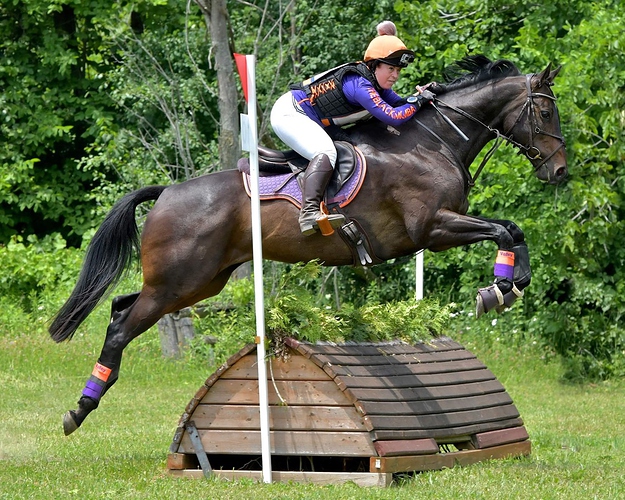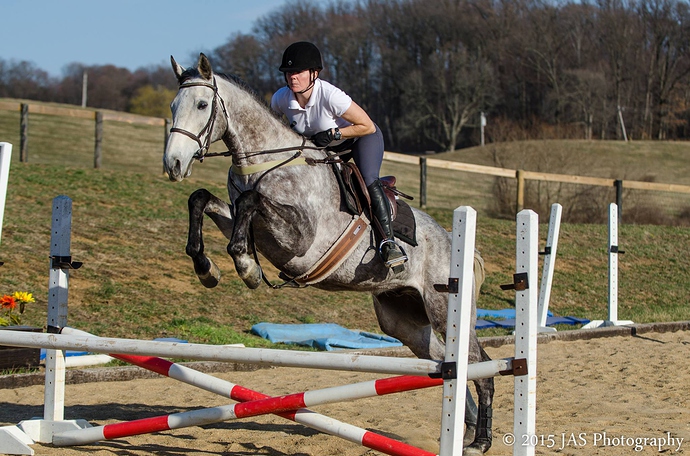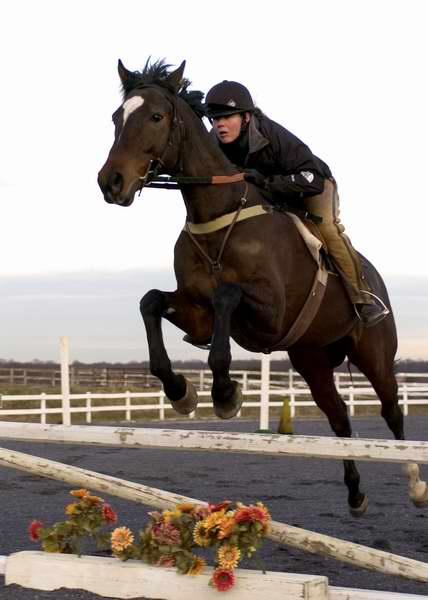Need encouragement, my new OTTB horse likes to step on poles, crash through cross rails, step over the fence, etc. My trainer tells me this is all normal when they are freshly off the track and learning how to jump. My last horse was allergic to wood so I’m nervous this one might be the opposite. When do they finally get it together?
Have you tried using a free jump chute or lunging? Sounds silly but sometimes I like to have them go over cavaletti (raised or on the ground) or small jumps so they can figure it out themselves without me being on them
I second this. Let him work it out on his own. Bonus if you can use medium-heavy rails. Not heavy enough to really scare him, but heavy enough to make an impression.
I am convinced that my TB learned to jump by watching other horses. She was not doing well learning to jump at all. Then she moved to a new stall where she looked out directly into the jumping arena so she watched lots of other horses doing lessons. Sounds crazy, but it seemed like she decided that if the other horses could jump she could too. I even think jealousy was involved. I bought another horse and moved him next door to her, and she did not like seeing him get my attention. I am convinced she watched us jumping and then decided to show him up. We even got a compliment about her jumping from Jimmy Wofford in a cross country clinic a year later.
Try working with poles on the ground. Randomly drop them around the arena and ride over them at w/t/c. It then doesn’t matter if the horse thumps them but he will learn to pick up his feet. Then try putting out four poles flat on the ground at 12, 3, 6 and 9 o’clock, making a reasonable circumference and circle over these, moving in towards the centre and out again (brilliant for supplying) at walk and trot. Again, he will learn to pick up his feet. Then set a line of trot poles, first flat on the ground, then raised at one side, then raised at both ends. All of these will help your horse learn but are also excellent exercises to work on jumping at any stage of training. And whilst thinking of poles, two on the ground at a random distance - about five strides - and ride them at a canter at five, or four, or six and that really helps develop adjustability.
ETA One other advantage of gymnastic pole work is that it keeps that busy TB brain engaged.
Agree with freejumping so they learn how to balance without a rider.
My 2-1/2yo OTTB (20 starts, 2 placings  ) was All Legs.
) was All Legs.
We set up a small X & longed him over it.
You could see him thinking about how to handle the obstacle 
As he got better, we made it into a vertical & he was handling 2’ by himself before we added a rider.
Uhhhhh… There are also ottbs who trot up to their first crossrail and canter softly and easily away.
If he’s telling you that jumping really isn’t his thing, Iit might be best to listen to him.
A lot of riders push the ottbs too fast because they are rideable off the track. How long has your horse been off the track? How much re-training have they had? How adjustable at the trot and canter are they? Do they respect a half halt and really accept your leg? How did you introduce jumping? I second the poster above who suggested poles. I literally went over some sort of pole every ride for a year while carefully sporadically throwing in a crossrail. Mine loves to jump but was clumsy too so he started off knocking things or just trotting jumps not actually jumping. We’re in year two of introducing jumping and he’s pretty point and shoot for low stuff. I’m on no timeline though it’s all for fun though.
I would not make any long term judgement on an ottb not wanting to jump until you’ve spent a good amount of time slowly introducing it.
Thanks for the suggestions. Of course if jumping is not his thing, I’m happy to figure out what he wants to do!
My horse was pretty straight forward teaching to jump. He did his first real canter w a rider up after his first cross rail. Later, he had a short phase of bumping things. For us, the problem was me - not enough leg. Once I focused on getting him more forward to the fence, he went back to popping over things like a pro. Maybe I was a little scared taking my neon green homebred over fences; I sucked back and horse followed suit.
One of mine was the same! I thought oh my what have I gotten into! Couldn’t pick up her legs AT ALL. I didn’t jump a whole lot for about 6 months just worked on the flat and when we went back to jumping she was completely different!
She’s never had a XC jump penalty. Don’t lose hope, perfect your flat work and build strength. The rest will come.
Pic of my once horrible jumper
maybe Jimmy Wofford’s “Modern Gymnastics” is helpful? It’s not in print anymore. But, you probably can find a copy. Plus, it is so worth reading everything he ever said. Also, sections of it are online. For example:
BIGGEST mistake ever made with teaching OTTB’s to jump…
Doing it in a ring. Or with copious amounts of boots on.
-
ALWAYS teach green horses over SOLID Natural obstacles. Logs, Coops, Stone Walls, Post and Rails, etc.
-
Use Bell boots and hind boots, leave the front open or in open fronts. They need to FEEL the jump when they make mistakes
-
If you aren’t confident asking them to do the first jumps like this on their back, then try it on a lunge but bring guide rails with you (one pole each side of the jump) to make it a more likely to be successful teaching moment.
-
Do not jump in a ring over non-solid obstacles until they can do solid obstacles well.
Photo proof of my jumpers that I taught with Solid obstacles.
That was Gin’s (2015 RRP Field Hunter Champion) first day jumping in a ring over poles. He had learned to jump over logs and then gone on 2 paper chases and jumped over the low natural stuff. This was 1 month into taking him off the track.
Lad first day jumping in a ring… 2 weeks into owning him/leaving the track. He learned on logs first.
Emily
How long has this been going on? Have you done a thorough lameness exam?
If this has been going on a while, I would start going through all the variables, starting with a vet check, saddle fit, different rider or training program.
I’ve found that if horses in a good, appropriate program don’t come along in a relatively normal timeframe, then there is likely something going on.
Please provide more context. Is this a truly young OTTB, e.g. right off the track at 2 or 3? I agree with your trainer.
My most recent OTTB went from
to this
In 4 years with very little poles on the ground etc. It came from lots of riding on the trails, living in pastures with all sorts of dangers, and simply riding correctly. I grew up with very little ground pole work with the philosophy that a horse learns to jump by jumping. I let them figure out where to put their body and legs over time.
Patience and trust are paramount. Don’t expect big changes even over the course of months. Look for tiny changes. I spent 2 years (about 150 hours of actual over fences) jumping 2’6" or under letting Peanut figure out life and how to jump. He didn’t figure out how to do a flying change on course until the 3rd year. Too many people jump on the “they don’t want to jump” bandwagon without actually ever letting the horse learn to jump. STOP.
You have to give these true OTTBs time to relearn how to use their bodies, build new muscle and coordination before you can ever assume you know what they can and want to do.
And some of them don’t. And that’s ok, they may just need more time. Or they may need a career change. Every horse is different.
Some see a jump, say “don’t wanna touch that”, jump like a freak and canter off.
Others see a jump, say “holy hell!! Holy shtt here it comes! Omg omg omg” and then throw themselves at it, landing flat, and taking off.
Some owners won’t let the horse canter big enough to a jump, then are surprised the horse is quick on the backside or learns to rush.
Could be a million things.
Op, let him figure it out on his own, he’s going to be fine. Just about every horse on earth can make it around a 3’ course, even if they’re not a natural at it. Set up some simple grids and have a good sense of humor about the whole thing yourself. It gets better.
The jumping will improve, as others have said when the dressage improves. He will then have the ability to adjust his stride.
I clicked on this thread, thinking it was about riders learning to jump, not horses. But pretty sure this quote applies to a lot of riders also.
A lot of the most visible Eventing pros take the youngsters out for their first xc schoolings on the lunge. Trotting, no rider. The horses know how to lunge, and then get to go hop logs, pop over ditches, trot up and down banks, splash around in the water. By the time they start learning to jump “for real”, they’ve seen a lot of things and been successful. Usually they go with more experienced horses being ridden, so there’s friends to follow over scary things to keep it from being a fight.
A friend also teaches her polo ponies to jump (they double as lesson horses/IEA mounts), and one took almost 2 years I think to figure out how to canter over a tiny jump. Now she’s Got It and lopes around no issue. There for a while it seemed like the mare was a jumping dud  . So, don’t write them off, but don’t pressure them to become perfect either!
. So, don’t write them off, but don’t pressure them to become perfect either!
This. Jumping gets better when the riding gets better.





